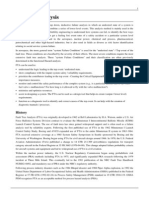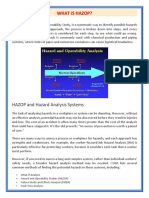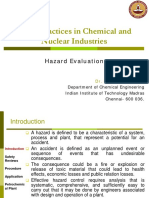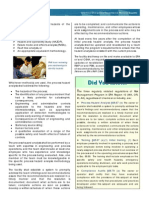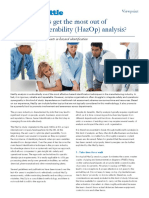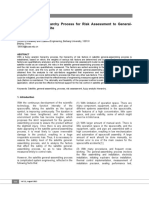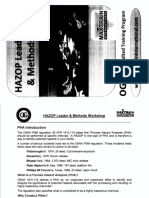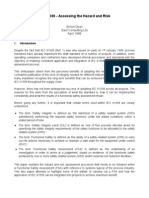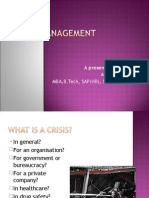0 ratings0% found this document useful (0 votes)
24 viewsOutline of Methods For Hazard and Risk Analysis
Outline of Methods For Hazard and Risk Analysis
Uploaded by
DLFThis document provides an outline of methods for hazard and risk analysis, including hazard surveys, Hazard and Operability Studies (HAZOP), Failure Modes and Effects Analysis (FMEA), fault tree analysis, event tree analysis, and safety audits. It describes each method and discusses how they are used to systematically identify hazards, analyze risks, and ensure safety in industrial plants and processes.
Copyright:
© All Rights Reserved
Available Formats
Download as PDF, TXT or read online from Scribd
Outline of Methods For Hazard and Risk Analysis
Outline of Methods For Hazard and Risk Analysis
Uploaded by
DLF0 ratings0% found this document useful (0 votes)
24 views4 pagesThis document provides an outline of methods for hazard and risk analysis, including hazard surveys, Hazard and Operability Studies (HAZOP), Failure Modes and Effects Analysis (FMEA), fault tree analysis, event tree analysis, and safety audits. It describes each method and discusses how they are used to systematically identify hazards, analyze risks, and ensure safety in industrial plants and processes.
Original Title
11347_08
Copyright
© © All Rights Reserved
Available Formats
PDF, TXT or read online from Scribd
Share this document
Did you find this document useful?
Is this content inappropriate?
This document provides an outline of methods for hazard and risk analysis, including hazard surveys, Hazard and Operability Studies (HAZOP), Failure Modes and Effects Analysis (FMEA), fault tree analysis, event tree analysis, and safety audits. It describes each method and discusses how they are used to systematically identify hazards, analyze risks, and ensure safety in industrial plants and processes.
Copyright:
© All Rights Reserved
Available Formats
Download as PDF, TXT or read online from Scribd
Download as pdf or txt
0 ratings0% found this document useful (0 votes)
24 views4 pagesOutline of Methods For Hazard and Risk Analysis
Outline of Methods For Hazard and Risk Analysis
Uploaded by
DLFThis document provides an outline of methods for hazard and risk analysis, including hazard surveys, Hazard and Operability Studies (HAZOP), Failure Modes and Effects Analysis (FMEA), fault tree analysis, event tree analysis, and safety audits. It describes each method and discusses how they are used to systematically identify hazards, analyze risks, and ensure safety in industrial plants and processes.
Copyright:
© All Rights Reserved
Available Formats
Download as PDF, TXT or read online from Scribd
Download as pdf or txt
You are on page 1of 4
Chapter 8
Outline of Methods for Hazard
and Risk Analysis
8.1 Introduction
Hazard and risk analysis is a large subject in itself, covered by a
substantial quantity of published information. The term hazard
analysis comprises a number of different systematic methods for
identifying the hazards to be associated with a given process or
plant. Such analyses can also be used as a basis for optimizing the
selection of means for preventing and mitigating dust explosions.
Risk analysis consists of four major steps: identification of a rep-
resentative set of failure cases, calculation of consequences, esti-
mation of failure probabilities, and assessment of overall impact.
Cox (1986, 1987) gave an informative summary of the various
techniques in use for hazard and risk analysis, which is quoted
more or less literally, under the following five headings.
8.2 Hazard Surveys or Inventories
These methods are essential preliminaries to many safety studies.
The survey consists of making an inventory of all stocks of haz-
ardous material or energy and noting relevant details of storage
conditions. When carried out at the conceptual stage of a project,
such a survey can contribute to layout optimization and may sug-
gest process changes to reduce stored quantities. It generates
information that can be used in a preliminary risk assessment, but
the hazard survey itself is little more than a "screening" exercise designed
to identify problem areas.
8.3 Hazard and Operability Studies (HAZOP) and Failure
Modes and Effects Analysis (FMEA)
These two techniques have very similar objectives and methods of
approach. The purpose is to identify systematically all of the possible
ways in which the system investigated could fail and to evaluate these and
formulate recommendations for preventive and mitigatory measures.
FMEA is the simpler of the two techniques. The procedure is to take each
plant item and component in turn, list all possible failure modes and con-
sider the consequences of each. The results are recorded in a standard
format in which recommendations for action can be included. The weak-
ness of FMEA is that there is no specified method for identifying the
failure modes and their effects. The engineer is expected to do this from
first principles or past experience, and the only discipline imposed on him
or her is that of the reporting format itself.
HAZOP overcomes this difficulty by introducing a systematic method for
identifying failure modes. This involves scrutiny of a large number of
possible deviations from normal operating conditions, which are gener-
ated by applying guide words such as more, less, reverse, etc., to each of
the parameters describing process conditions in each component, plant
item, or line in the plant. However, HAZOP in its original form has disad-
vantages, and some industrial companies have modified the way in which
the results of the study are handled. Instead of "recommendations," the
output is "identified problems," leaving more room for a coordinated
rational design revision that is not only cheaper, but also probably safer.
8.4 Analysis of Systems Reliability by Fault Tree Analysis
This method is applied to complex systems, whether the complexity is
due to the nature of the process itself or to the instrumentation required
for running the process. In the basic technique, the "Fault Tree Analysis,"
the failure modes must first be identified, e.g. by HAZOP. These failure
modes are named "top events." An example of a "top event" could be a
dust explosion in a milling plant.
For each "top event." the analyst must then identify all those events or
combinations of events that could lead directly to the failure. The precise
logical relationship between cause and effect is expressed by AND or OR
gates and is usually presented in diagrammatic form. The immediate
causes of the top event have their own contributory causes, and these can
be presented in a similar way so that a complete fault tree is built up. This
process ceases when all of the causative factors at the bottom of the tree
are of a simple kind for which frequencies of occurrence or probabilities
can be estimated.
The synthesis of fault tree is a job that is best done by an engineer with
good experience of the type of system under consideration. It is much
easier to teach such a person how to construct a fault tree than to teach a
reliability specialist everything about the system. However, the quantita-
tive analysis of a fault tree is a separate activity in which the reliability
specialist will play the dominant role.
An illustrative example of a quite comprehensive fault tree for a grain
dust explosion in a grain storage facility was given by National Materials
Advisory Board (1982).
8.5 Quantitative Risk Analysis by Event Tree Analysis
Quantitative risk analysis (QRA) consists of the following steps.
Failure cases are identified first by establishing the location of the main
inventories of hazardous material and then by scrutinizing in detail the pro-
cess flow and instrumentation diagrams using checklist methods or HAZOP.
Once the failure cases have been identified, the consequences of the
failure must be calculated. Event tree analysis is a useful method in this
process. An event tree is the reverse of a fault tree, starting with the initial
or "bottom events" and exploring all possible "top events" that can result
from it. Each outcome has further outcomes and all of these can be related
by means of decision gates. At each gate the conditional probabilities
must be estimated for each of the alternative branches. On this basis the
probabilities of the final hazard, or 'top event', can be calculated.
Criteria have been suggested whereby calculated risks can be judged.
Almost all criteria proposed so far are based on the concept of compara-
bility with the existing general risk background. Cost/benefit and "risk
perception" arguments have been advanced.
Risk analysis has been criticized by pointing at
• inaccurate mathematical models
• incomplete analysis of actual practical problem
• inaccurate primary failure probability data
• inadequate acceptability criteria
• difficulty of checking final result
• complexity and laboriousness of method
Hawksley (1989) discussed the conditions under which the various ele-
ments of quantitative risk analysis are useful in the assessment of risks in
practice.
8.6 Safety Audits
Once a plant enters operation, hardware and procedures will start to
change from those originally established by the commissioning team.
Usually, there are good reasons for this: the plant engineers and operators
may find simpler or more economic procedures, and the operational
requirements themselves may change. However, it is also quite possible
that safety standards fall off with time because experience of satisfactory
operation leads to overconfidence and a false sense of security.
For these reasons, safety audits are used in many operating companies.
These may vary from a half-day tour by the works manager to a review
lasting several weeks carried out by a team of engineers covering dif-
ferent disciplines and independent of the regular operational management
of the plant. For the most penetrating audits, the study should not be
announced in advance.
You might also like
- RDC 430 - English VersionDocument16 pagesRDC 430 - English VersionpriyabrataNo ratings yet
- Chapter 14 InteractiveDocument8 pagesChapter 14 InteractiveAmita50% (2)
- Manuals Specifications Glossary November 2016Document285 pagesManuals Specifications Glossary November 2016Sunil BhoriaNo ratings yet
- Guidelines for Defining Process Safety Competency RequirementsFrom EverandGuidelines for Defining Process Safety Competency RequirementsRating: 3 out of 5 stars3/5 (1)
- Nps Technical Rescue Handbook 2014 PDFDocument292 pagesNps Technical Rescue Handbook 2014 PDFMatheus Baños100% (2)
- Nflat BookDocument105 pagesNflat Bookajayuseless93% (15)
- Root Cause AnalysisDocument7 pagesRoot Cause Analysisolivia523No ratings yet
- List of Documents ISO 13485 Documentation ToolkitDocument4 pagesList of Documents ISO 13485 Documentation ToolkitGreeshma Certvalue100% (3)
- Fault Tree AnalysisDocument8 pagesFault Tree Analysisankitsaxena123No ratings yet
- Atos Data Center Services BrochureDocument7 pagesAtos Data Center Services BrochurejeysamNo ratings yet
- Principles Hazop Fta Eta FmeaDocument2 pagesPrinciples Hazop Fta Eta FmeaDidier Hung Leung SangNo ratings yet
- SHM - Practical 12 - Risk Assessment MethodsDocument8 pagesSHM - Practical 12 - Risk Assessment MethodsBhaliya AadityaNo ratings yet
- Fault Tree AnalysisDocument7 pagesFault Tree AnalysisthawdarNo ratings yet
- Risk Anaylsis by Hybrid Hazop and Fmea TechniqueDocument12 pagesRisk Anaylsis by Hybrid Hazop and Fmea TechniqueGiuseppe GoriNo ratings yet
- ReliabilityDocument4 pagesReliabilitymurilobpessanhaNo ratings yet
- What Is Hazop?: HAZOP and Hazard Analysis SystemsDocument5 pagesWhat Is Hazop?: HAZOP and Hazard Analysis SystemsMuhammad Hamza NaveedNo ratings yet
- Process Safety Management: A Legal and Technical Overview: Session No. 526Document15 pagesProcess Safety Management: A Legal and Technical Overview: Session No. 526Waqas Ahmad KhanNo ratings yet
- Semi-Quantitative Fault Tree Analysis For Process Plant Safety Using Frequency and Probability RangesDocument7 pagesSemi-Quantitative Fault Tree Analysis For Process Plant Safety Using Frequency and Probability RangesRonak MotaNo ratings yet
- Applying Process Hazard Analysis To Laboratory HVAC Design: Ashrae JournalDocument4 pagesApplying Process Hazard Analysis To Laboratory HVAC Design: Ashrae JournalhvananthNo ratings yet
- A Method For Barrier-Based Incident InvestigationDocument7 pagesA Method For Barrier-Based Incident InvestigationEzatollah Salary100% (1)
- Hazard EvaluationDocument48 pagesHazard Evaluationanpuselvi125100% (2)
- Risk Considerations For Installation of A New Autoclave in A Pharmaceutical Manufacturing FacilityDocument29 pagesRisk Considerations For Installation of A New Autoclave in A Pharmaceutical Manufacturing Facilitygadhang dewanggaNo ratings yet
- Highlight On "Hazop" For Engineering Safety ReviewDocument8 pagesHighlight On "Hazop" For Engineering Safety ReviewliamsiNo ratings yet
- Industrial Process Hazard Analysis: What Is It and How Do I Do It?Document5 pagesIndustrial Process Hazard Analysis: What Is It and How Do I Do It?Heri IsmantoNo ratings yet
- Root Cause Analysis: Ruksana Hamid, Medical Officer and Anesthesiologist, JK HealthDocument7 pagesRoot Cause Analysis: Ruksana Hamid, Medical Officer and Anesthesiologist, JK HealthAnar HajiyevNo ratings yet
- Fertil Hazop StudyDocument9 pagesFertil Hazop Studypkannan0% (1)
- Failure Mode Effect Analysis and Fault Tree Analysis As A Combined Methodology in Risk ManagementDocument12 pagesFailure Mode Effect Analysis and Fault Tree Analysis As A Combined Methodology in Risk ManagementandrianioktafNo ratings yet
- Root Cause AnalysisDocument12 pagesRoot Cause Analysisosalp internationalNo ratings yet
- Selection of Hazard Evaluation Techniques PDFDocument16 pagesSelection of Hazard Evaluation Techniques PDFdediodedNo ratings yet
- Did You Know?: Chemical Emergency Prevention & PlanningDocument9 pagesDid You Know?: Chemical Emergency Prevention & PlanningShirleyNo ratings yet
- Certificate Course Module 1 Part CDocument47 pagesCertificate Course Module 1 Part Camyrb9088No ratings yet
- HAZOPDocument7 pagesHAZOPfairusNo ratings yet
- OCCUPATIONAL AND SAFETY (2)Document23 pagesOCCUPATIONAL AND SAFETY (2)daisyfavor35No ratings yet
- Safety: 1.2.1. Qualitative Hazard Analysis TechniquesDocument5 pagesSafety: 1.2.1. Qualitative Hazard Analysis TechniquesZeyad ZeitounNo ratings yet
- Spe Spe-146192 "Learning The Lessons - Retrospective Hazops"Document8 pagesSpe Spe-146192 "Learning The Lessons - Retrospective Hazops"Vinh Do ThanhNo ratings yet
- Equipment Autoclave Risk Assesment - EXCELLENTDocument28 pagesEquipment Autoclave Risk Assesment - EXCELLENTASHOK KUMAR LENKA67% (3)
- hazidDocument6 pageshazidJOTHIMUTHUNo ratings yet
- Lecture 06 Risk AnalysisDocument20 pagesLecture 06 Risk Analysisrowan mamdouhNo ratings yet
- New HAZOP MethodologyDocument25 pagesNew HAZOP Methodologycnaren67100% (1)
- 5 - HazopDocument23 pages5 - HazopMuhammad Raditya Adjie PratamaNo ratings yet
- XBRA 3103 OSH Risk Management Assignment Jan 2020 V1Document16 pagesXBRA 3103 OSH Risk Management Assignment Jan 2020 V1Amran Sharif100% (4)
- Chemical Engineering Science: Seyed Javad Hashemi, Salim Ahmed, Faisal I. KhanDocument11 pagesChemical Engineering Science: Seyed Javad Hashemi, Salim Ahmed, Faisal I. KhanafsuarezcoNo ratings yet
- Abnormal Situation Management in Process Control: Do We Have It Under Control?Document11 pagesAbnormal Situation Management in Process Control: Do We Have It Under Control?Neera JainNo ratings yet
- Risk Reduction of Operating Procedures and Process FlowsheetsDocument27 pagesRisk Reduction of Operating Procedures and Process FlowsheetsAnonymous 5PGSwX5No ratings yet
- Safety Engineering: Felipe A. Arnejo Ii Sheila Marie C. Cagadas Jamelee S. Marzonia John Henry V. MoratallaDocument11 pagesSafety Engineering: Felipe A. Arnejo Ii Sheila Marie C. Cagadas Jamelee S. Marzonia John Henry V. MoratallaSheila Marie CagadasNo ratings yet
- System Failure Analysis: Much Like The Work of A DetectiveDocument8 pagesSystem Failure Analysis: Much Like The Work of A DetectiveKrishna BelelaNo ratings yet
- Plant Safety and LayoutDocument34 pagesPlant Safety and LayoutMuhamad Baihakhi ShamsudinNo ratings yet
- Process Hazards Analysis MethodsDocument1 pageProcess Hazards Analysis MethodsRobert MontoyaNo ratings yet
- Integration of HAZOP and FMEA AnalysisDocument13 pagesIntegration of HAZOP and FMEA Analysischem_taNo ratings yet
- Accident Investigation Root Cause AnalysisDocument4 pagesAccident Investigation Root Cause AnalysisIr Azil Awaludin MohsNo ratings yet
- Safety Engineer Safety Engineering Is An Engineering Discipline Which Assures That Engineered SystemsDocument5 pagesSafety Engineer Safety Engineering Is An Engineering Discipline Which Assures That Engineered SystemsJohn Nate RiveraNo ratings yet
- Practical Implementation of "Risk Assessment" Through Process Safety Management SystemsDocument6 pagesPractical Implementation of "Risk Assessment" Through Process Safety Management SystemseastNo ratings yet
- Paper 75 - Ellis - Hazards XVIIDocument11 pagesPaper 75 - Ellis - Hazards XVIINitesh KirnakeNo ratings yet
- Adl Hazop Analysis-MinDocument4 pagesAdl Hazop Analysis-MinJosué Chávez CastellanosNo ratings yet
- Tian & Yan 2013Document10 pagesTian & Yan 2013Francy SantamariaNo ratings yet
- Session 11 12 - FMECADocument21 pagesSession 11 12 - FMECASusanoo12No ratings yet
- Sciencedirect: Hazard and Operability Analysis (Hazop) of Mobile Mooring SystemDocument5 pagesSciencedirect: Hazard and Operability Analysis (Hazop) of Mobile Mooring Systeming.enrique.navarreteNo ratings yet
- Comparison of Pha Methods PDFDocument10 pagesComparison of Pha Methods PDFQayyum KhanNo ratings yet
- Xxii Paper 10Document9 pagesXxii Paper 10Ariyandi Yuda PraharaNo ratings yet
- Hazard Operability Study (HAZOP) in A Fertiliser Plant: K. Muthukumar, M. Suman MohanDocument7 pagesHazard Operability Study (HAZOP) in A Fertiliser Plant: K. Muthukumar, M. Suman MohanŘëhmàñ ÀĺîNo ratings yet
- Beyond FMEA The Structured What-If Techn PDFDocument13 pagesBeyond FMEA The Structured What-If Techn PDFDaniel88036No ratings yet
- HazopDocument51 pagesHazopsaadNo ratings yet
- Iec 61508Document14 pagesIec 61508Pandhu DewantoNo ratings yet
- Optimization Under Stochastic Uncertainty: Methods, Control and Random Search MethodsFrom EverandOptimization Under Stochastic Uncertainty: Methods, Control and Random Search MethodsNo ratings yet
- Application of Probabilistic Methods for the Safety Assessment and the Reliable Operation of Research ReactorsFrom EverandApplication of Probabilistic Methods for the Safety Assessment and the Reliable Operation of Research ReactorsNo ratings yet
- Quality Assurance and Quality Control in Neutron Activation Analysis: A Guide to Practical ApproachesFrom EverandQuality Assurance and Quality Control in Neutron Activation Analysis: A Guide to Practical ApproachesNo ratings yet
- UK Offshore Safety Directive - Safety Case (2015)Document162 pagesUK Offshore Safety Directive - Safety Case (2015)absahkah100% (1)
- Risk Assessment Report - Skka TempleDocument20 pagesRisk Assessment Report - Skka TempleYazhisai Selvi100% (1)
- The Risk Management of EverythingDocument15 pagesThe Risk Management of EverythingUntuk KegiatanNo ratings yet
- Matching Monitoring, Risk Allocation and Geotechnical Baseline ReportsDocument6 pagesMatching Monitoring, Risk Allocation and Geotechnical Baseline ReportsAdeshola FunmilayoNo ratings yet
- 2.3 INOGATE - Software and Tools For Risk Assessment (Rev.2)Document33 pages2.3 INOGATE - Software and Tools For Risk Assessment (Rev.2)Dimasqi TaufikNo ratings yet
- Adaptive Risk Management System (ARMS) : Mihaela UlieruDocument58 pagesAdaptive Risk Management System (ARMS) : Mihaela Ulierusiti rodiyahNo ratings yet
- SECP Annual Report 2018 LowDocument138 pagesSECP Annual Report 2018 LowBilal ZaidiNo ratings yet
- Crisis ManagementDocument74 pagesCrisis ManagementAmit Sharma50% (2)
- Assignment 2 Front Sheet: Qualification BTEC Level 5 HND Diploma in ComputingDocument40 pagesAssignment 2 Front Sheet: Qualification BTEC Level 5 HND Diploma in ComputingDũng Hoàng TiếnNo ratings yet
- 01 - Guidance - Machine Safe GuardingDocument29 pages01 - Guidance - Machine Safe GuardingAmjad Wael Yahia FayedNo ratings yet
- Problem Solving TL9000 (Update 25.feb)Document46 pagesProblem Solving TL9000 (Update 25.feb)Sunseeker Nguyen100% (1)
- Annual Report 2022 23Document120 pagesAnnual Report 2022 23anilNo ratings yet
- Final Report of DMCBLDocument68 pagesFinal Report of DMCBLJakaria KhanNo ratings yet
- Sample Risk Management WorksheetDocument2 pagesSample Risk Management WorksheetAleksandra PirogNo ratings yet
- Akw 104 Accounting & Finance Lecture 4: Cash & Internal ControlDocument17 pagesAkw 104 Accounting & Finance Lecture 4: Cash & Internal ControlmuitsNo ratings yet
- Wood County EOP 2017Document278 pagesWood County EOP 2017Doc RedNo ratings yet
- 9100 Series Rev Overview PDFDocument49 pages9100 Series Rev Overview PDFSelvaraj SimiyonNo ratings yet
- Application-Portfolio-Governance - Software AgDocument24 pagesApplication-Portfolio-Governance - Software AgRohitNo ratings yet
- DRRM ManualDocument243 pagesDRRM ManualMarie Antoneitte Lyka GuilengNo ratings yet
- 2023 HNO - Nigeria - v0.8 - Latest Update 20 MarchDocument142 pages2023 HNO - Nigeria - v0.8 - Latest Update 20 MarchAbdullahi MustaphaNo ratings yet
- Clinical Investigation UpdateDocument28 pagesClinical Investigation UpdateMarcBenetPozoNo ratings yet
- Report Format For Needs AssessmentDocument3 pagesReport Format For Needs Assessmentchenaddy.dfbNo ratings yet
- Administrative Aspects of ProjectDocument5 pagesAdministrative Aspects of ProjectKaran RawatNo ratings yet








